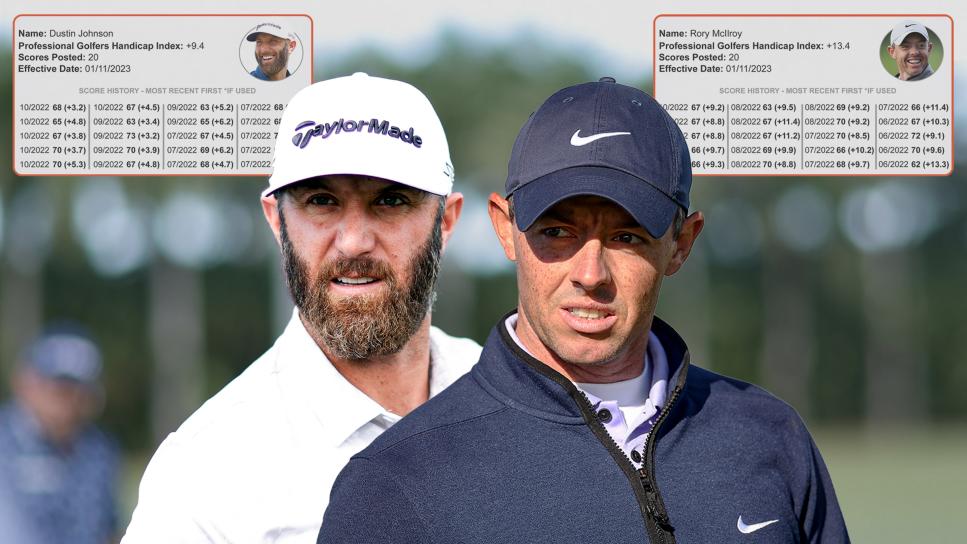Problem Solving
My solution for ranking pro golfers might be crazy enough to work

For most golfers, the currency that measures our skill is a handicap. It is a measure not only of our scores, but the difficulty of where we play. Both factors are essential.
Why don’t pros need handicaps? Because pros always play straight up, and the handicap’s main purpose is to help players of different abilities arrive at a form of fair competition. But a handicap system among pros—or at least a slight variation—might come in handy somewhere else.
For those not paying attention, professional golf is at an inflection point. There are competing professional golf tours, and a series of major championships caught in the middle asked to determine who is eligible to play in them and who isn’t. For now, those majors rely on the Official World Golf Ranking (OWGR) to make many of those calculations, but that system has critics, too.
The central conflict: The OWGR is not granting ranking points for LIV Golf events, which means LIV players are dropping in the rankings and risk being shut out of future majors. Are those players actually getting worse? Not really, and therein lies the problem. Any system dependent on comparing golfers’ performances in specific events becomes problematic the moment you start debating the validity of one tour’s events versus another’s.
But what if the system that assessed players’ merit relied less on who they played against and more on how they played on specific courses? In other words, what if professional golf had something like its own handicap?
Introducing the Pro Golf Handicap
Now, before we go any further with this idea, a couple of caveats. The concept I am floating would at some point rely on a fairly intricate algorithm, but that algorithm should be devised by just about anyone other than this college English major. Second, the reason the current system is flawed is because it contains some inherent bias, and my concept aspires to circumvent the most problematic areas. But some subjectivity is inevitable, so the challenge is to at least place the judgment calls into the least fraught elements.
This will make sense. Stay with me.
Anyway, back to the handicap system, which at its core asks two questions: What did you shoot? And where did you play? You need both because golfers recognize a 70 from the tips at Winged Foot is way more difficult than a 70 on a 5,700-yard course with flat greens and no hazards.
But for pro golfers, two questions aren’t enough. The level of talent in professional golf is deeper than ever. Plenty of players post absurdly low scores on mini-tours, and while it’s widely conceded the PGA Tour has the most difficult setups, not all of the other tours' golf courses are pushovers. Yet should all those players be eligible for the Masters? Probably not.
Knowing that, the first deviation for the Pro Golf Handicap (PGH) would be the need for a deeper analysis of the golf courses, which I’m calling the Adjusted Course Rating (ACR). Remember, at the highest levels of golf, the layouts players must navigate in tournament play hardly resemble what an average player faces on normal weeks. Rough is higher, greens are faster, pins are tucked closer to the edges.
In a Pro Golf Handicap, there would need to be a course rating system that also factors in setup variables, which is to say, shooting 70 at Winged Foot from the tips is already damn good, but if you’re doing it under U.S. Open conditions, it’s elite. How would we arrive at this calculation? It could be a combination of factoring in fixed numbers—green speeds, rough height, distances of pins from collars—but also comparing the scores to the field average that day. Strokes-gained formulas are devised similarly, and the OWGR has one of those, too, but for reasons I’ll explain later, the OWGR’s strokes-gained metric is also problematic.
Not just where, but when
So the Adjusted Course Rating is one unique requirement of a Pro Handicap. The other is admittedly even more complex, because as we know, a professional golfers’ performance is not just about what they shoot and where, but when. The significance of the tournament, what was at stake, whether they started the day with the lead or were 10 strokes back—this is another layer of context that contributes to a scores’ degree of difficulty. Again, if we agree there’s a difference between shooting 70 on different course setups, we can probably also agree there’s a difference between shooting 70 on Thursday morning of a Korn Ferry Tour event and Sunday evening of a U.S. Open. For this formula to work, it would require a combination of historical data (a final-round leader’s average score, etc) and other considerations that factor in a round’s specific challenge.
The Professional Golf Handicap* = ([Adjusted Course Rating x Situational Difficulty Index] - 18-hole Tournament Score) ÷ Tournament Rounds*As designed by an English major
Admittedly, this Situational Difficulty Index (SDI) requires some subjectivity to determine why one round of golf is more important than another, and it immediately raises the sticky question of what magnitude should be assigned to a tournament’s history or “prestige”* (which would presumably favor long-running PGA Tour or DP World Tour events over the inaugural LIV Golf events). So yes, some of this criteria will require real decisions by real people, but the goal is for the data to take over from there.
(*There’s also the even murkier question of money. One might assume the more money at stake in an event the greater the magnitude, and in some cases that’s true. BUT … if a tour is throwing piles of money at players to begin with and even last place money is guaranteed and significant, one could argue the payout ceases to play a determining role.)
So could this actually work? Could a Pro Handicap actually replace the OWGR as a fairer way of measuring one player against another? Here it’s important to remember the problem we’re trying to solve, and the reasons why the current system doesn’t do it. Beyond LIV Golf’s infamous source of funding, its detractors will say its competitive product is inferior, a tour seeking legitimacy by way of slapping a few zeroes at the end of tournament purses. In the absence of World Ranking points for its events, players who aren’t otherwise exempt for majors will slip further down the OWGR until they’re shut out altogether.
To which you might say, tough luck. This was the choice those players made when joining LIV. Maybe that’s true, but remember, the major championships are the most important events in golf because they bring the best players in the game together on the best courses. To exclude LIV golfers from competing jeopardizes that promise, in turn undermining the majors’ importance. This could be bad for golf.
So if we want the best players in golf eligible for the most important tournaments, then we need an apples-to-apples method to determine a player’s current level of play. The OWGR is currently reviewing LIV Golf’s application to award World Ranking points, but it appears that LIV tournaments won’t satisfy the OWGR requirements for inclusion and perhaps understandably. Winning a LIV Golf event—over just 54 holes, against a 48-man field—isn’t as demanding as a PGA Tour event played over 72 holes against 155 other players.
But shouldn’t those performances count for something? And if so, how?
The OWGR, and to an extent even its own strokes-gained world rating, is more concerned with how golfers fare against one another than how they fare against the assortment of courses they play. The objective of a golf tournament is to win, of course, so winning would need to be rewarded in the PGHI formula. But the OWGR’s reliance on strength of field also makes it a self-fulfilling prophecy: a field’s strength is determined by the World Ranking of its players, which those players achieve by playing in events with strong fields. (Raise your hand if your head hurts.)
The Pro Handicap, meanwhile, eliminates most of the subjectivity of determining one tournament’s worth over another, and returns to the simpler questions of how well you play on these level of courses under these specific circumstances. Again, if the objective is to round up the most qualified golfers for the most important tournaments, this could do it.
If a LIV golfer not already exempt wants to prove why he deserves inclusion in the most important tournaments, the path to do so would be there. But that path is narrower for a reason. An Adjusted Course Rating would reflect LIV courses that are set up generally easier than those on the PGA Tour, and the Situational Difficulty Index would likely reveal most LIV tournament rounds by definition don’t present as steep a challenge. You’re playing against only 47 players, for starters, and since the formula gives greater weight to rounds as tournaments progress, LIV’s 54-hole format means its final round won’t be as “heavy” as the fourth round of a 72-hole event.
If you’ve read this far, it’s because you either think the Pro Handicap has real merit or because you think it’s so absurd you can’t look away. In fact both might be true. The Pro Handicap is indeed an imperfect system. But given the imperfect state of golf these days, and the imperfect system it endeavors to replace, it still might actually work.


